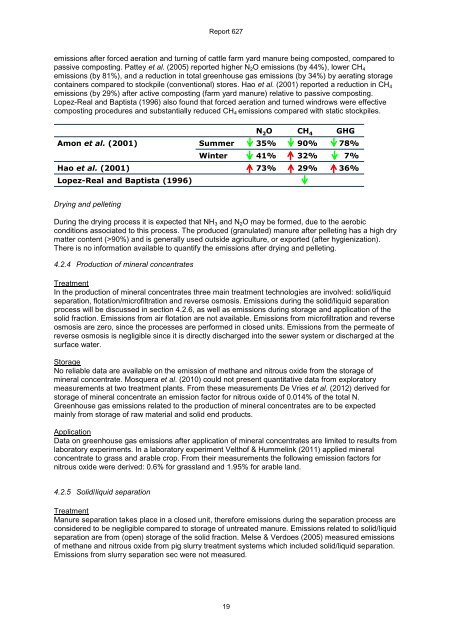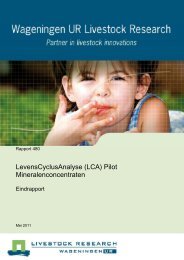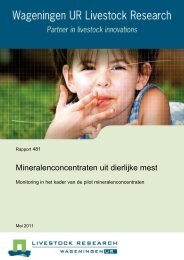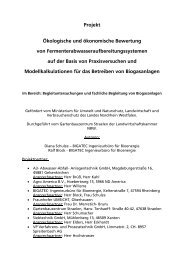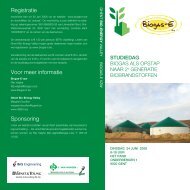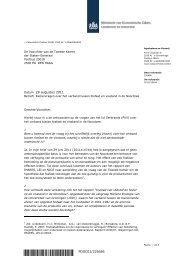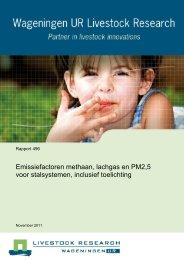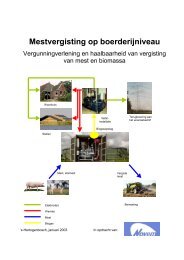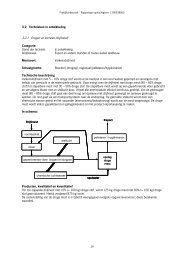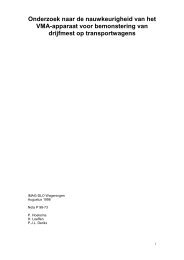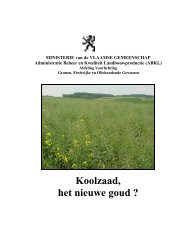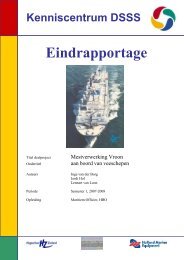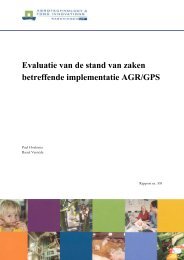Monitoring methane and nitrous oxide reduction by manure treatment
Monitoring methane and nitrous oxide reduction by manure treatment
Monitoring methane and nitrous oxide reduction by manure treatment
You also want an ePaper? Increase the reach of your titles
YUMPU automatically turns print PDFs into web optimized ePapers that Google loves.
Report 627<br />
emissions after forced aeration <strong>and</strong> turning of cattle farm yard <strong>manure</strong> being composted, compared to<br />
passive composting. Pattey et al. (2005) reported higher N2O emissions (<strong>by</strong> 44%), lower CH4<br />
emissions (<strong>by</strong> 81%), <strong>and</strong> a <strong>reduction</strong> in total greenhouse gas emissions (<strong>by</strong> 34%) <strong>by</strong> aerating storage<br />
containers compared to stockpile (conventional) stores. Hao et al. (2001) reported a <strong>reduction</strong> in CH4<br />
emissions (<strong>by</strong> 29%) after active composting (farm yard <strong>manure</strong>) relative to passive composting.<br />
Lopez-Real <strong>and</strong> Baptista (1996) also found that forced aeration <strong>and</strong> turned windrows were effective<br />
composting procedures <strong>and</strong> substantially reduced CH4 emissions compared with static stockpiles.<br />
Drying <strong>and</strong> pelleting<br />
During the drying process it is expected that NH3 <strong>and</strong> N2O may be formed, due to the aerobic<br />
conditions associated to this process. The produced (granulated) <strong>manure</strong> after pelleting has a high dry<br />
matter content (>90%) <strong>and</strong> is generally used outside agriculture, or exported (after hygienization).<br />
There is no information available to quantify the emissions after drying <strong>and</strong> pelleting.<br />
4.2.4 Production of mineral concentrates<br />
Treatment<br />
In the production of mineral concentrates three main <strong>treatment</strong> technologies are involved: solid/liquid<br />
separation, flotation/microfiltration <strong>and</strong> reverse osmosis. Emissions during the solid/liquid separation<br />
process will be discussed in section 4.2.6, as well as emissions during storage <strong>and</strong> application of the<br />
solid fraction. Emissions from air flotation are not available. Emissions from microfiltration <strong>and</strong> reverse<br />
osmosis are zero, since the processes are performed in closed units. Emissions from the permeate of<br />
reverse osmosis is negligible since it is directly discharged into the sewer system or discharged at the<br />
surface water.<br />
Storage<br />
No reliable data are available on the emission of <strong>methane</strong> <strong>and</strong> <strong>nitrous</strong> <strong>oxide</strong> from the storage of<br />
mineral concentrate. Mosquera et al. (2010) could not present quantitative data from exploratory<br />
measurements at two <strong>treatment</strong> plants. From these measurements De Vries et al. (2012) derived for<br />
storage of mineral concentrate an emission factor for <strong>nitrous</strong> <strong>oxide</strong> of 0.014% of the total N.<br />
Greenhouse gas emissions related to the production of mineral concentrates are to be expected<br />
mainly from storage of raw material <strong>and</strong> solid end products.<br />
Application<br />
Data on greenhouse gas emissions after application of mineral concentrates are limited to results from<br />
laboratory experiments. In a laboratory experiment Velthof & Hummelink (2011) applied mineral<br />
concentrate to grass <strong>and</strong> arable crop. From their measurements the following emission factors for<br />
<strong>nitrous</strong> <strong>oxide</strong> were derived: 0.6% for grassl<strong>and</strong> <strong>and</strong> 1.95% for arable l<strong>and</strong>.<br />
4.2.5 Solid/liquid separation<br />
Treatment<br />
Manure separation takes place in a closed unit, therefore emissions during the separation process are<br />
considered to be negligible compared to storage of untreated <strong>manure</strong>. Emissions related to solid/liquid<br />
separation are from (open) storage of the solid fraction. Melse & Verdoes (2005) measured emissions<br />
of <strong>methane</strong> <strong>and</strong> <strong>nitrous</strong> <strong>oxide</strong> from pig slurry <strong>treatment</strong> systems which included solid/liquid separation.<br />
Emissions from slurry separation sec were not measured.<br />
19<br />
N 2O CH 4 GHG<br />
Amon et al. (2001) Summer 35% 90% 78%<br />
Winter 41% 32% 7%<br />
Hao et al. (2001) 73% 29% 36%<br />
Lopez-Real <strong>and</strong> Baptista (1996)


